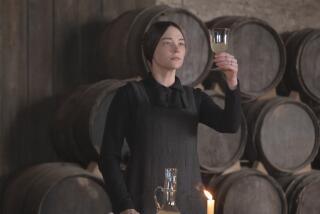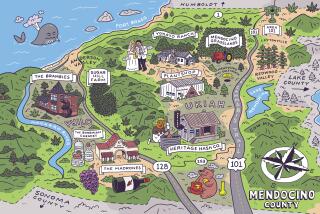Rhone Grapes, Raspberries and Flying âCigarsâ : Former Flower Child Randall Grahm Makes Outstanding, Unusual Wines--and Even Welcomes Spaceships to His Bonny Doon Vineyard
FOR WINE LOVERS--and parents--Randall Grahmâs Bonny Doon Vineyard in the Santa Cruz Mountains is a gratifying story of personal development that brings true adventure to our wining and dining.
Wine maker Grahm is the first-born son of Alan Grahm, importer, and his wife Ruth. The tall, lanky, long-haired Randall (who, with his brother and sister, had rebelled against family convention in â60s flower-child fashion) majored in philosophy at UC Santa Cruz after graduation from Beverly Hills High School. After three years, he thought his direction might be medicine, but a one-semester transfer to pre-med at MIT quickly taught him that this would not be his field. He returned to philosophy and Santa Cruz, somehow along the way discovering wines, viticulture and enology, which led him to UC Davis and his final degree in viticulture and enology.
Up among the redwoods and other conifers of Santa Cruz, Dick and Tommy Smothers had established a small winery in a forest clearing and were making some remarkably fine wines, winning a sweepstakes award for their Late Harvest Gewurztraminer, reported in this column in the mid-â70s. The comedians wisely trusted their wine making to a pro, who hired Randall as assistant wine maker.
Ruth Grahm told me how pleased her husband had been when Randall seriously applied himself to planting the vineyard and making wines; Alan Grahm was delighted when Randall phoned with the news that heâd won a bronze medal at one showing and then two golds at another fair. Who cared, now, that Randall Grahm still had long hair? His son the wine maker was a winner.
Competition in markets and on restaurant wine lists is fierce among the 676 California wineries, and recognition is tantamount to survival. The fight for space demands uncommon drive, intelligence, persistence and wit. Randall Grahm has all three qualities in abundance. This 34-year-old former philosophy major has calluses on his hands from hard labor in the field and cellar and an untiring mind to cope with inventive approaches to merchandising and exhaustive examination of varietal-grape-growing areas in the whole Western region, all bound together with the goal of making world-class wines of uncommon interest to the sincere wine lover.
Grahm calls one of his wines Le Cigare Volante, which literally means âflying cigar,â the French concept of a flying saucer. In 1954, Grahm asserts, villagers near the Chateauneuf-du-Pape winery banned the landing of flying saucers, or flying cigars, in their vineyards. As he was growing the same Rhone varieties of grapes, in itself an offbeat idea, Grahm sent his own message into space--a sign in his vineyard that said âwelcome cigare volante .â
Every vintage of this Cigare Volante blending of Grenache, Syrah and Mourvedre has been sold out on release. There are always repeat sales because the wine is fabulously good, flavor-intense from those mountain grapes. The same is true of his estate-grown Chardonnay. When I arrived at the winery for my second visit recently, Randall Grahm walked into the tasting room with two lab samples of opaque juice, one strawberry-red, the other purple-red. âRaspberry?â I asked. He nodded, smiling.
âFor the new dessert âInfusionsâ?â He replied by pouring out samples of both.
âThatâs Hood variety strawberries from Mount Vernon, Wash. It has neutral grape spirits added to make it about 14% alcohol. This one is a special raspberry.â
He watched closely as I tasted each one, each being an incredible translation of the berry to quaffing nectar.
Then we were off in the pickup truck to see the vineyard, two miles up the road from the winery.
There are 25 acres, laboriously planted, grafted, fenced and mesh-covered against the birds. There were rows of Chardonnay with tiny ripe berry clusters; the Mt. Eden clone yields less than one ton per acre.
âWeâre going to bud these vines over to Rhone varieties. I make a good Chardonnay, but economically this vineyard is a total loss.â
Grahmâs face bore no trace of bitterness. His mind was already enjoying the thought of his new adventure, freezing ripe mature grapes for making ice wine, without the waiting gamble of trusting Mother Nature to do her thing, or the trauma of middle-of-the-night harvesting. Iâve already tasted (and favorably reported here) the 1986 California Muscat Canelli âVin de Glaceâ ($15 for 375 milliliters).
âIâd like to freeze Gewurztraminer, Semillon and Grenache. Theyâd make very interesting and delicious ice wines, as good as the Muscat Canelli,â he said.
More to Read
Eat your way across L.A.
Get our weekly Tasting Notes newsletter for reviews, news and more.
You may occasionally receive promotional content from the Los Angeles Times.










